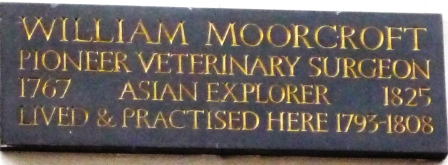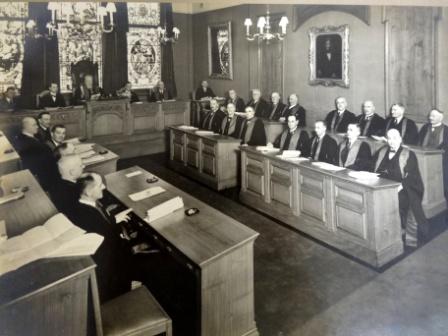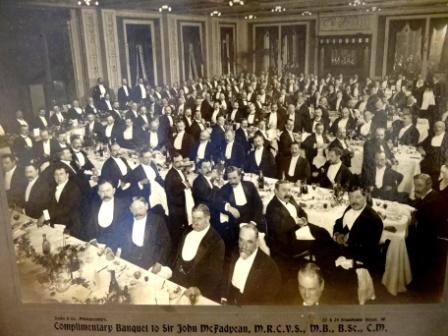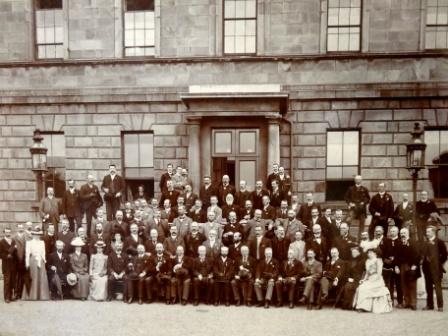London, like most towns or cities, has lots of plaques commemorating people or events attached to its buildings. Most of these plaques are above eye level and often go unnoticed by people passing by.

Site of plaque commemorating William Moorcroft
One such plaque is sited on the left-hand side of Oxford Street, when walking down from Marble Arch, on the block just before Portman Street. As you can see from the photo above – it is quite hard to spot as it is small, high up and surrounded by garish shop displays.
A close up of the plaque, which was erected by the Veterinary History Society in 1982, reveals that it commemorates the fact that William Moorcroft, veterinary surgeon, lived and practiced on the site from 1793-1808.

Plaque on the site of William Moorcroft’s practice
William Moorcroft 1767-1825 was born in Ormskirk, Lancashire the grandson of a wealthy landowner and farmer. In the early 1780s he was apprenticed to a surgeon in Liverpool but during an outbreak of an unknown cattle disease he was recruited to help treat the stricken animals. Moorcroft impressed the local landowners so much that they offered to underwrite his education if he gave up his plans to study surgery and went instead to the veterinary school in Lyon, France.
This he did, arriving in France in 1789, graduating a year or so later as the first Englishman to qualify as a veterinary surgeon.
Returning to London he set up in practice at 224 Oxford Street (the street has since been renumbered). In 1794 Moorcroft was made joint Professor, with Edward Coleman, of the London Veterinary College. However the arrangement only lasted a few weeks before he resigned seemingly because of the difficulties of combining academic life with a thriving business. The Oxford Street practice continued to grow, with Moorcroft recruiting John Field, firstly as his assistant and then later as his partner, until it became one of the most lucrative in London.
As well as his work in the practice Moorcroft also purchased breeding stock for the East India Company and in 1803 was appointed manager of their stud in Essex. Then in 1808 he was appointed as Superintendent of the East India Company’s stud in Bengal at a salary of £3,000 a year (the size of the salary offered to Moorcroft gives some indication of just how successful the practice must have been).
Thus began the part of his life for which Moorcroft is perhaps better known. As well as improving the control of disease in the stud in Bengal he established a number of subsidiary studs and introduced a co-operative breeding programme with the local population. However the breeding programme still did not produce the type of horse that was needed for cavalry and artillery purposes and Moorcroft began to look further afield.
In 1811 he travelled some 1500 miles across North India looking for new breeding stock. Then in May 1812 he set out on a second journey, with Captain Hyder Hearsey, this time looking for both horses and as a side issue the Tibetan shawl goat. (Moorcroft saw the goat as offering an opportunity for increased trade between the company and the locals).
Their journey took them through Kumaon and the Niti Pass into Tibet, finally ending at Lake Manasarovar, and resulted in the purchase of Kashmir goats, some of which eventually ended up in Scotland, but little in the way of horses. Perhaps not surprisingly Moorcroft’s employers were not impressed – his primary purpose had been to look for horses and he came back with goats! – and they curtailed his travels for a number of years.
In 1819 Moorcroft embarked on what was to be his final – 6 year long – journey. Visiting Ladakh (1820-1822), Kasmir and the Punjab (1822-1823), Afghanistan (1824-1824), Turkestan (1824-1825), finally reaching Bokhara, in modern Uzbekistan, on 25th February 1825. He died from fever on the return journey on 27 August 1825.
William Moorcroft, – pioneering veterinary surgeon and Asian explorer – quite a story which the plaque only hints at. Want to find out more? Then check out some of the books listed below.
Further reading
Alder, Garry (1985) Beyond Bokhara : The Life Of William Moorcroft, Asian Explorer And Pioneer Veterinary Surgeon, 1767-1825 London: Century Publishing
Irwin, John (1973) The Kashmir shawl London : HMSO
Travels in the Himalayan Provinces of Hindustan and the Punjab, in Ladakh and Kashnair, in Peshawur, Kabul, Kunduz and Bokhara, from 1819 to 1825: by William Moorcroft and George Trebeck: prepared from the press from original journals and correspondence by H. H. Wilson. London: 1845 (reprinted New Delhi : Sagar Publications 1971)






